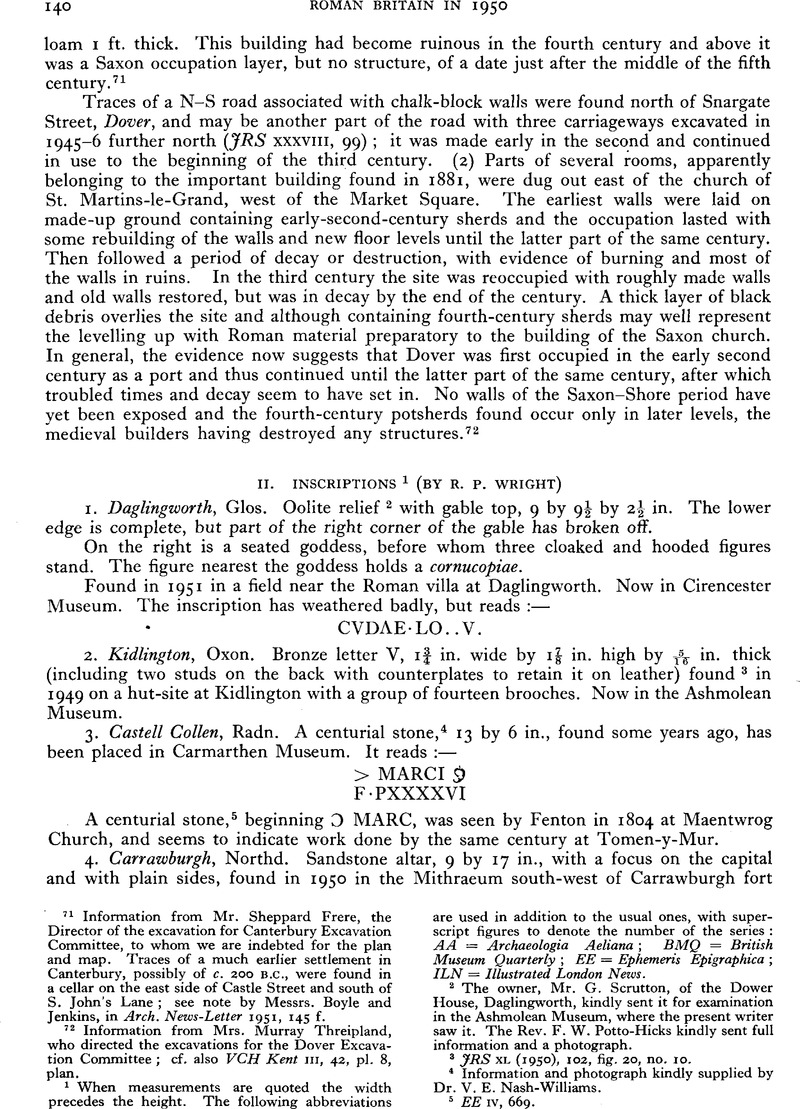Article contents
Abstract

- Type
- Roman Britain in 1950
- Information
- Copyright
- Copyright ©R. P. Wright 1951. Exclusive Licence to Publish: The Society for the Promotion of Roman Studies
References
1 When measurements are quoted the width precedes the height. The following abbreviations are used in addition to the usual ones, with super script figures to denote the number of the series: AA = Archaeologia Aeliana; BMQ = British Museum Quarterly; EE = Ephemeris Epigraphica; ILN = Illustrated London News.
2 The owner, Mr. G. Scrutton, of the Dower House, Daglingworth, kindly sent it for examination in the Ashmolean Museum, where the present writer saw it. The Rev. F. W. Potto-Hicks kindly sent full information and a photograph.
3 JRS XL (1950), 102Google Scholar, fig. 20, no. 10.
4 Information and photograph kindly supplied by Dr. V. E. Nash-Williams.
5 EE IV, 669.
6 AA4 XXVIII (1950), 136Google Scholar.
7 CIL VII, 1150; EE IX, 1249. Now in Tudor House Museum, Southampton.
8 Six other milestones of Gordian have been found: at Bitterne, , CIL VII, 1149Google Scholar; Gwennap, , JRS XXXIV (1944), 88Google Scholar; Aberavon, , CIL VII, 1159Google Scholar = EE VII, 1098; Scalesceugh, , CW2 XVI, (1916) 282Google Scholar; Lanchester, , CIL VII, 1183Google Scholar; Wellington, , JRS XXXIII (1943), 80Google Scholar.
9 B.M. ms. Cotton Julius C. VI, f. 37, commenting on Calpurnius Agricola: ‘Tabula plumbea nuper aratro eruta in agro Wellensi cum inscriptione nominis Antonini et Veri ab hoc forsan Calp. Agricola erecta fuit.’ Leland wrongly thought that the lead ingots were trophies. Details kindly sent by Mr. T. C. Skeat.
10 CIL VII, 1201; EE IX, p. 642; VCH Somerset1, 340.
11 It occurs on a Domitianic diploma, ILS 1997, and in Rome, CIL VI, 611.
12 ILS 6700, sevir apparently of Verona.
13 Nash-Williams, , Bulletin of Celtic Studies XIII (1950), 242, fig. 9Google Scholar.
14 Dr. D. B. Harden kindly cites a similar fragment from Vindonissa (Brugg Museum, no. 6826) which may well be from the same mould.
15 Brailsford, ILN 26th August, 1950, 306, with plate; BMQ XVI (1951), 18 f.Google Scholar, with plate.
15a Holder Altcelt. Sprachsch. cites seven instances in Gaul and N. Italy.
16 Toynbee, and Clarke, , JRS XXXVIII (1948), 20Google Scholar. Now in Norwich Museum.
17 Mr. G. Webster kindly sent full details.
18 Mr. G. Webster kindly sent full details.
19 JRS XL (1950), 96Google Scholar. The tiles are in South Shields Museum.
20 JRS XI (1921), 239Google Scholar, pl. XXIII, 2.
21 Mr. F. H. Thompson, who undertook the work for the Ministry of Works, kindly sent the brick and full details.
22 Mr. N. Cook kindly made available this, and other, finds now placed in Guildhall Museum. See above, p. 135.
23 Mr. S. S. Frere kindly sent this, and two other, fragments from Canterbury. See above, p. 139.
24 For the Walbrook site, see above, pp. 135 f.
25 Mr. M. H. Callender suggested [Gem]ellum, and the present writer the rest. For gemellum cf. CIL XV, 4572. Pliny, NH XIV, §22, says that one variety of vine was named from its twin clusters.
26 Mr. Dare consulted the present writer about the interpretation and published it in Arch. Cant, LXII (1949), 94Google Scholar, with figure.
- 1
- Cited by




